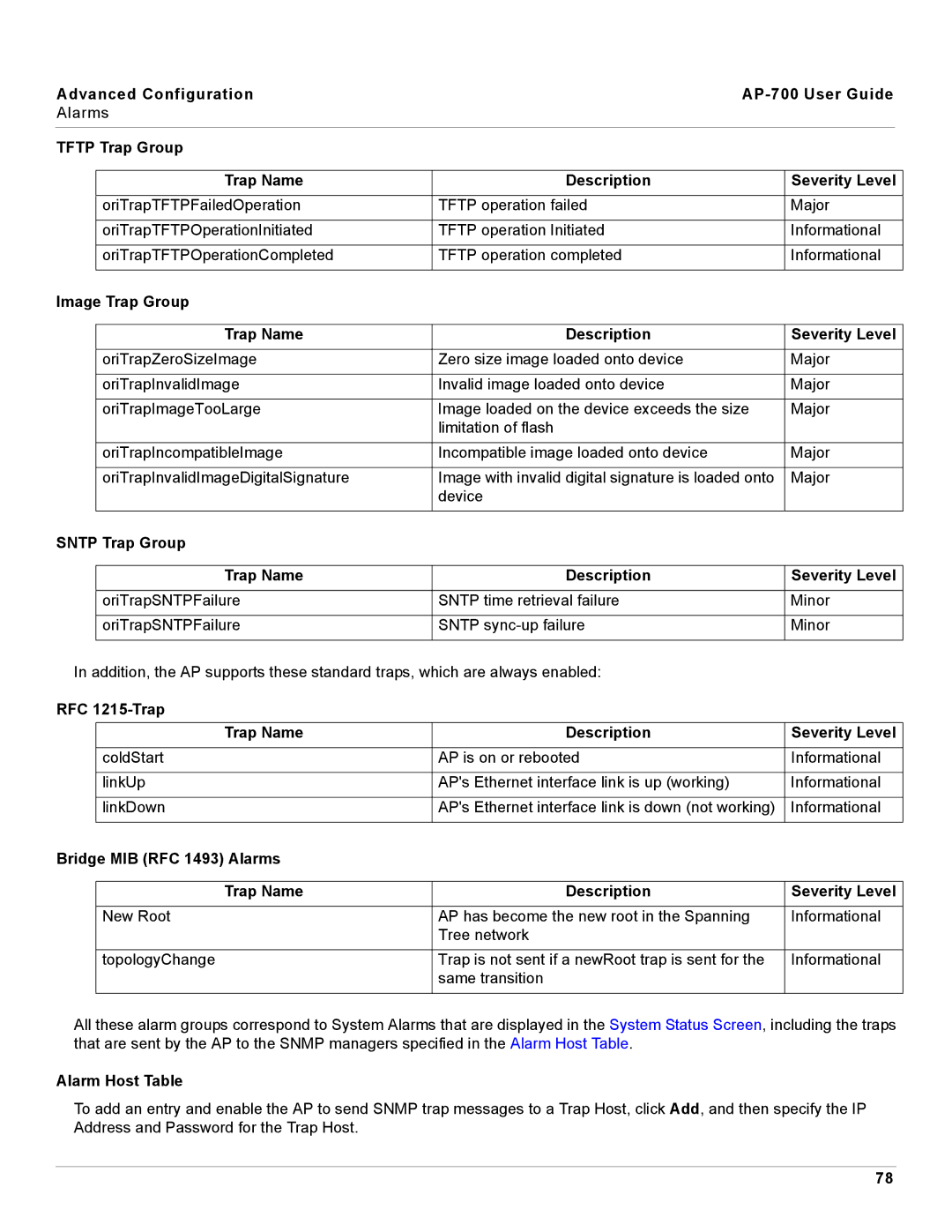Advanced Configuration |
| |||
Alarms |
|
|
| |
|
|
|
|
|
TFTP Trap Group |
|
|
| |
|
|
|
| |
| Trap Name | Description | Severity Level | |
|
|
|
| |
| oriTrapTFTPFailedOperation | TFTP operation failed | Major | |
|
|
|
| |
| oriTrapTFTPOperationInitiated | TFTP operation Initiated | Informational | |
|
|
|
| |
| oriTrapTFTPOperationCompleted | TFTP operation completed | Informational | |
|
|
|
|
|
Image Trap Group |
|
|
| |
|
|
|
| |
| Trap Name | Description | Severity Level | |
|
|
|
| |
| oriTrapZeroSizeImage | Zero size image loaded onto device | Major | |
|
|
|
| |
| oriTrapInvalidImage | Invalid image loaded onto device | Major | |
|
|
|
| |
| oriTrapImageTooLarge | Image loaded on the device exceeds the size | Major | |
|
| limitation of flash |
|
|
|
|
|
| |
| oriTrapIncompatibleImage | Incompatible image loaded onto device | Major | |
|
|
|
| |
| oriTrapInvalidImageDigitalSignature | Image with invalid digital signature is loaded onto | Major | |
|
| device |
|
|
|
|
|
|
|
SNTP Trap Group |
|
|
| |
|
|
|
| |
| Trap Name | Description | Severity Level | |
|
|
|
| |
| oriTrapSNTPFailure | SNTP time retrieval failure | Minor | |
|
|
|
| |
| oriTrapSNTPFailure | SNTP | Minor | |
|
|
|
|
|
In addition, the AP supports these standard traps, which are always enabled:
RFC 1215-Trap
| Trap Name | Description | Severity Level |
| coldStart | AP is on or rebooted | Informational |
|
|
|
|
| linkUp | AP's Ethernet interface link is up (working) | Informational |
|
|
|
|
| linkDown | AP's Ethernet interface link is down (not working) | Informational |
|
|
|
|
Bridge MIB (RFC 1493) Alarms |
|
| |
|
|
|
|
| Trap Name | Description | Severity Level |
|
|
|
|
| New Root | AP has become the new root in the Spanning | Informational |
|
| Tree network |
|
|
|
|
|
| topologyChange | Trap is not sent if a newRoot trap is sent for the | Informational |
|
| same transition |
|
|
|
|
|
All these alarm groups correspond to System Alarms that are displayed in the System Status Screen, including the traps that are sent by the AP to the SNMP managers specified in the Alarm Host Table.
Alarm Host Table
To add an entry and enable the AP to send SNMP trap messages to a Trap Host, click Add, and then specify the IP Address and Password for the Trap Host.
78
